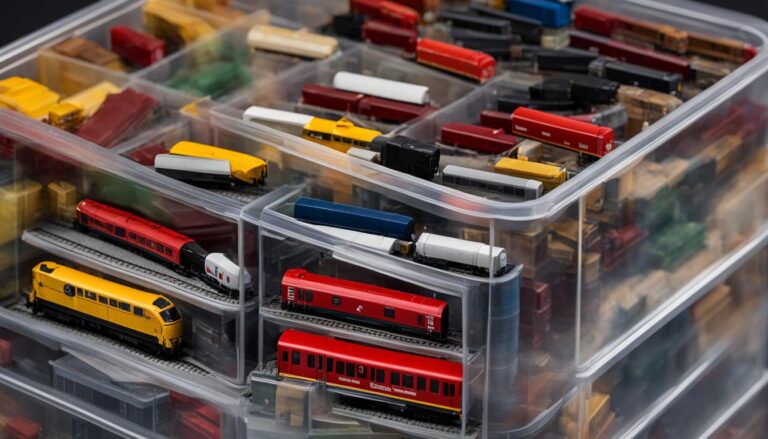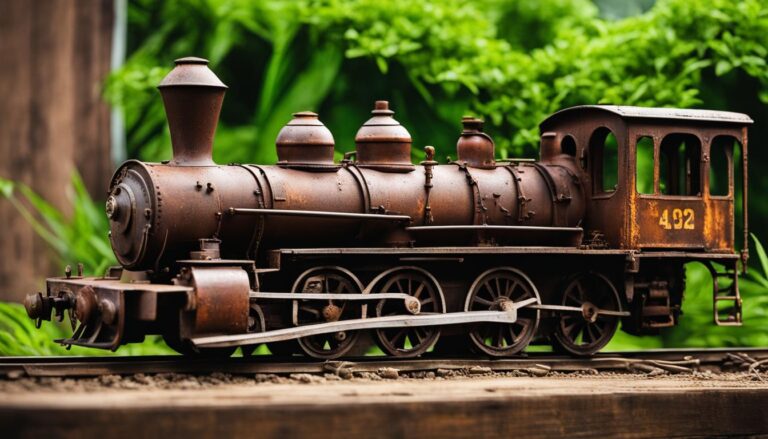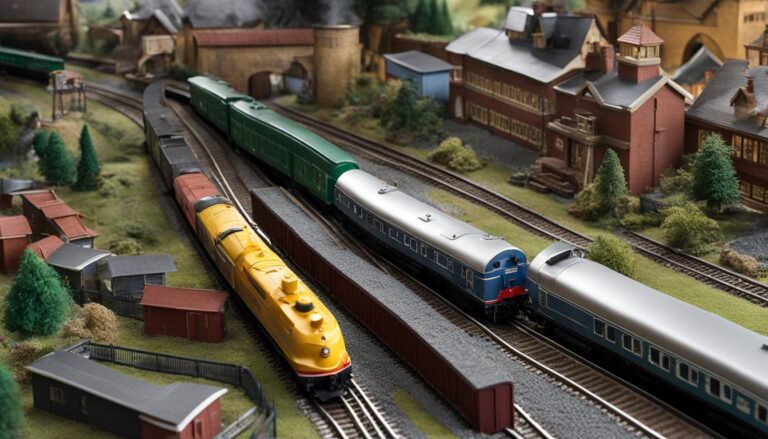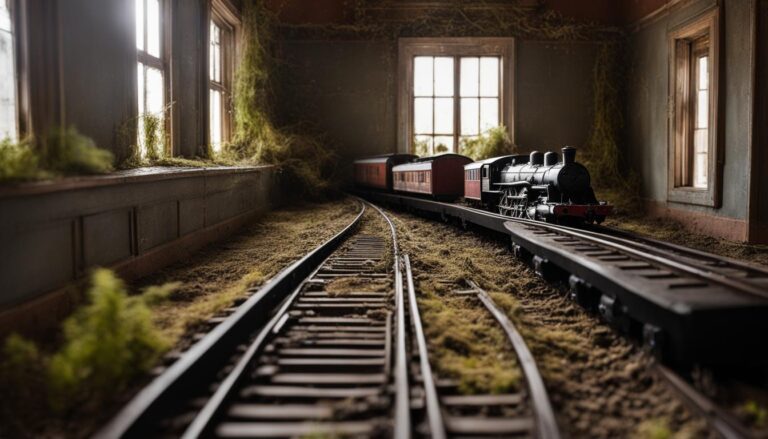Model Railway Shelf Layouts: Top Tips
Calling all people who love model railroads! If you’ve always wanted to build your own small railway but don’t have much room, model railway shelf layouts are the perfect answer for you. You can make your train dreams come true in a creative and space-saving way with these cleverly designed plans that fit snugly on shelves or other small surfaces.
These article are full of tips, ideas, and inspiration to help you make your own model railway shelf layouts, whether you’re new to model railroading and want to try it out or an expert modeler looking for new things to do. Get ready for a thrilling trip through the interesting world of compact railroads!
Key Takeaways:
- Model railway shelf layouts are a creative way for train fans who don’t have enough room for a standard model railway to save space.
- There are many good things about shelf layouts, such as making the model more like a real train, being small, and being inexpensive.
- It’s important to carefully plan and think about available room, track arrangement, and aesthetic factors when making a shelf layout.
- Adding switching operations and planning different situations for interesting train movements are ways to get the most out of a shelf layout.
- Even though they are small, shelf plans can look very real thanks to scenery, weathering, scale models, and fine details.
- Model railway shelf layouts are a clever way for train fans to save space when they don’t have enough room for a large model railway.
- Shelves are great because they make the model look more like a real train, they’re small, and they don’t cost much.
- When setting up a shelf, it’s important to carefully plan and think about the space you have, how the tracks will fit, and how it will look.
- To get the most out of a shelf layout, you can add switching operations and plan different scenarios for trains to move through.
Benefits Of Shelf Layouts
Shelf layouts are a popular choice among model railroad fans because they have many benefits. First, these small models make a realistic representation of a real train system. Shelf layouts move like real trains do because they have straight tracks and point-to-point operations.
In addition, shelf layouts save space. These layouts fit in compact spaces, making them ideal for modelers with limited space. If you live in a small apartment or hobby room, a shelf layout helps you enjoy model railroads without taking up valuable space.
Shelf layouts are not only practical and small, but they are also cheap. Because they need less track and moving stock, they may be a cheaper choice for modelers who are trying to save money. You can make a plan that is interesting to read and looks good without spending a lot of money.
Overall, shelf plans are a popular choice among people who like model railways because they have many benefits. You can make an exciting model railroad experience in a small, cost-effective way with these because they are realistic, small, and cheap.
| Benefits of Shelf Layouts for Model Railways |
|---|
| Realistic representation of a full-scale railway system |
| Compact design fits into small spaces |
| Cost-effective option with fewer tracks and rolling stock |
Designing a Shelf Layout: Tips and Considerations
There are a few important things to think about when making a shelf plan for your model railroad. From space planning the room to arranging the tracks and adding scenery, every part is important for making a layout that looks good and works well. Let’s look at some ideas and tips that will help you make your own interesting shelf plan.
Space Planning
Before planning your shelf layout, measure your space. The surface you use and its size and shape should be considered. Measure the space carefully and jot down any constraints or issues that may effect your design options. Planning the area lets you customize the layout to match your needs and environment.
Track Arrangement
A very important part of shelf layout design is how the tracks are set up. Plan ahead of time by thinking about how the trains will get through the tight area. Think about how things will work and figure out the best way to set up the tracks to get the plan you want. Whether you like a simple point-to-point layout or a more complicated track plan with lots of loops and crosses, arranging your tracks carefully will make your shelf layout look more real and work better.
Scenic Elements
Adding scenery to your shelf plan is a great way to make it look better and make people feel like they are in a real miniature world. You might want to add buildings, trees, roads, and other landscape details that fit with your theme. To keep things realistic, pay close attention to their size and balance. Try out different colors, textures, and materials to make an environment that is interesting to look at, tells a story, and catches people’s imaginations.
“Space, track configuration, and scenery must be considered when designing a shelf layout. By following these tips and considering your model railway’s needs, you can construct a beautiful and functional shelf layout that brings your miniature world to life.”
In Summary
Designing your model railway shelf layout requires thoughtful consideration. Ensure efficient space planning, optimize track arrangement to support realistic train movements, and incorporate captivating scenic elements. By carefully balancing these aspects, you can create a visually engaging and functional shelf layout that will captivate viewers and provide hours of enjoyment in your miniature world.
Maximizing Operations For Model Railway Shelf Layouts
When it comes to model railway shelf layouts, one of the key elements that enthusiasts strive for is maximizing operations. The goal is to create a layout that offers realistic and varied train movements, keeping the experience engaging and dynamic. This can be achieved by incorporating switching operations into the design, allowing trains to pick up and drop off cars at different industries and sidings.
Modelers can design an unlimited train operation layout by preparing situations and problems. A well-designed shelf layout can give operators hours of fun moving trains through complex track layouts or industries with unique tasks.
To further enhance the operations on a shelf layout, consider incorporating varied scenarios that require different train movements. This can include tasks such as delivering goods to different destinations, shunting cars between sidings, or even running passenger trains with specific schedules. The key is to create a layout that offers a range of operations, providing a diverse and interesting experience for the operator.
How to Get the Most Out of Model Railway Shelf Layouts
Model train shelf layout enthusiasts prioritize operation efficiency. To keep things interesting, the layout should let trains travel precisely and variedly. We should construct switching operations so trains can pick up and drop off vehicles at different industries and sidings.
By considering scenarios and impediments, modelers can create a layout with many train routes. A well-designed shelf plan can provide the operator hours of enjoyment running trains through difficult track layouts or through industries with particular jobs.
Add conditions that require different train movements to improve shelf layout operations. Transporting products, moving vehicles between sidings, and keeping passenger trains on time are examples. Make sure the operator has fun and a varied experience to create a versatile plan.
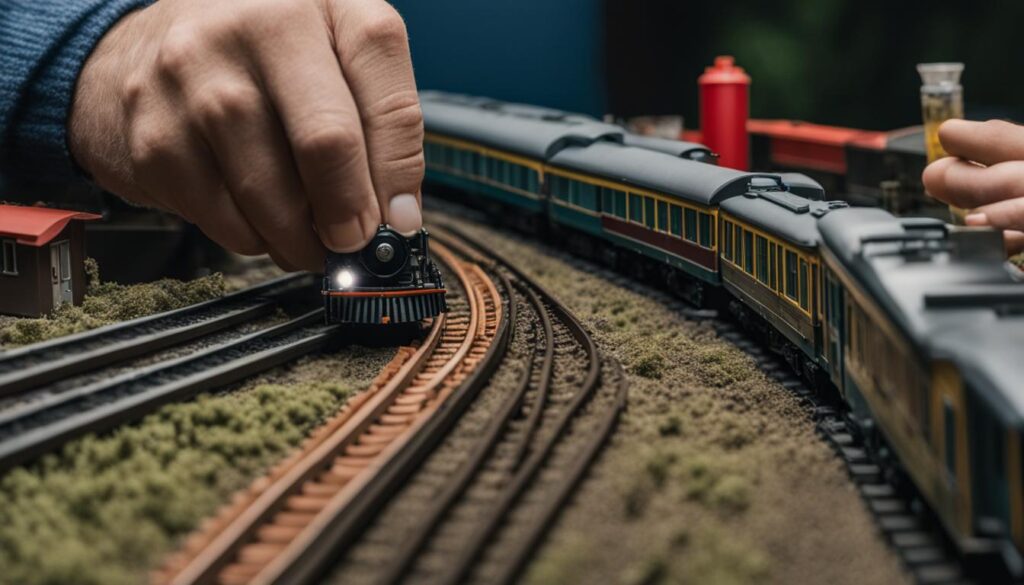

Selecting the Perfect Backdrops for Your Model Train Layout
Getting the right backdrops for your model train setups can turn them from good to great. Let’s start with some easy ideas!
Painted Backdrops:
Get ready to show off your artistic side!
Backdrops that are painted give you a lot of options and let your imagination run wild. It’s time to paint your model train layout and make it come to life. The great thing about painted sets is that they are flexible, so you can change the scene to fit your needs. On top of that, it’s a cheap choice that won’t break the bank. So, explore the world of colors and make a background that is all your own.
Printed Photo Backgrounds:
Printing photos on the backgrounds of your model railroad shelf plans will make them look more real.
These backgrounds give your plan a lifelike look that makes it look good. Carefully think about the viewpoint and make sure that the background and foreground blend together. Because of advances in printing technology, you can pick from many scenes to suit your tastes. Printed photo backgrounds come in many styles, from busy cities to peaceful landscapes, and can make your model train shelf layouts look more real.
3D Diorama Walls:
With 3D diorama walls, you can make your model train shelf layouts look even better.
These walls not only give your scene depth, but they also fit right in with the rest of the design. Picture your tracks being supported by complex bridges and buildings that are surrounded by lots of greenery. The 3D effect makes the surroundings move, which gives your layout a more realistic look. 3D diorama walls are a great way to make your model railway layout look even better, whether you want it to look like a mountain scene or an urban one.
You can paint your own backdrops:
Paint your own backgrounds to show off your artistic skills.
This do-it-yourself method not only makes your model train plan more unique, but it’s also a cheap way to improve it. Choose a color scheme and some paint brushes. Then, let your ideas run wild. Painting your own backdrops lets you be creative without spending a lot of money. You can use them to recreate a favorite scene or make up a whole new setting. It’s a great way to give your model railroad shelf layouts a special look that shows off your own style and tastes.
Use Software to Design Prints:
Use software to make prints for your model railway layout and join the digital age.
This choice gives you the freedom to change your backgrounds with just a few clicks. Try out different scenes and themes to make the design fit your needs. People who are crazy about model trains will like this method because it is budget-friendly. So, turn on your computer, let your imagination run wild, and make prints that will take your plan to a whole new level.
Make your own 3D walls:
People who want to be in charge and make complex plans should build 3D walls from scratch.
Taking this hands-on method lets you make walls that are exactly what your layout needs. The options are endless, from rough mountain scenery to busy cityscapes. Start building and play around with different materials and textures to get the look you want. When you build 3D walls from scratch, your model train layout will be a one-of-a-kind work of art that shows how much you love and care about trains.
Pay attention to the edges and changes:
When you’re done with your model train backdrop, pay close attention to the edges and changes between the layers.
For a realistic and aesthetically pleasing plan, smooth blending is a must. Make sure that there are no abrupt changes in the way things look as they move from one part to the next. By paying attention to the edges and changes, you can make your model train world look better overall. It’s the finishing touch that makes the whole thing come together, giving both viewers and model train fans a cohesive and intense experience.
Lighting and Shadows:
Lighting and shadows are very important for making your model train layout look more real.
Think about where to put light sources so that they look like natural light. This careful attention to detail gives your scene more depth and dimension. The shadows that buildings and tracks cast add to the overall realism. Try out different lighting arrangements to find the one that makes your plan look its best. By adding accurate lighting and shadows, you give your model train world life and make it more interesting and fun to be in.
Alignment with Track Layout:
Make sure you stay accurate by making sure your backdrops are perfectly lined up with your track layout.
A well-aligned background makes your model train world look better as a whole. Think about the positioning and view to make the tracks and the background blend in well. This care with alignment not only makes your plan look better, but it also makes it seem more real. By making sure everything works together, you can make a model train world that looks great and is fun to play with and run.
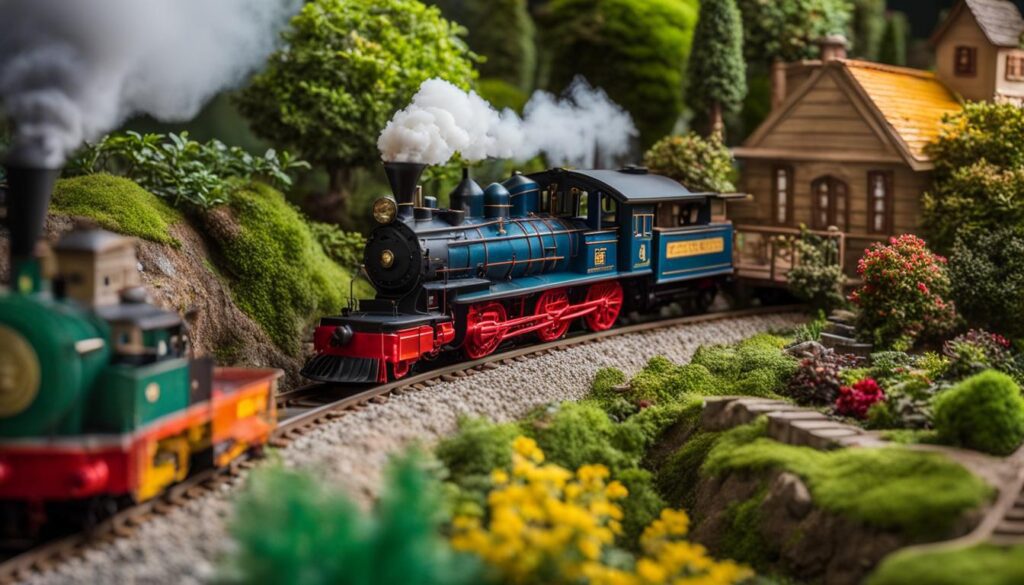

Budgeting and Managing Costs
Create an Expenses Sheet:
Before you start planning, you should make a full expenses sheet.
Make a list of all the things you’ll need for your model train layout, like tracks, buildings, scenery, and more. Don’t forget about the tools you’ll need; they’re what will hold your project together. Include extras like paint, glue, and nails to avoid spending more than you planned. This sheet will become your financial road map and help you figure out how to control your budget. Figure out ways to save money:
Identify Cost-Saving Measures:
Use smart ways to save money to help you stick to your budget.
In order to save money, choose to buy products in bulk. During sales, take advantage of the chance to save money on things you need. Replace more expensive things with cheaper ones; be smart and planned about what you choose.
Set Spending Limits:
Set clear limits on your spending when it comes to money.
Save up a certain amount of money for the tracks, buildings, and scenery on your model railway layout. Set daily and weekly spending limits to stay on top of your money. Leave room for extras, knowing that you might have to pay for things you didn’t plan for. Sticking to this plan will help you stay within your financial comfort zone.
Track Expenses Closely:
Keep track of your spending very carefully to help you figure out your finances.
Write down all of your prices and keep track of every penny you spend. Check your financial records often and make changes to your budget as needed. Make line-item budgets that divide costs into clear groups. This proactive money management makes sure that you can see and control how much your model railway shelf layouts costs.
Plan Layout Completion in Phases:
Start saving money right away by planning to finish your layout in stages.
Put important parts like tracks and structures at the top of the list and work on those first. Remember that Rome wasn’t built in a day as you work on each area. This step-by-step method not only lets you focus on the most important parts, but it also saves you money up front, making building your model train layout a rewarding and financially sound trip.
To sum up
When planning your model train shelf layout, you need to give it a lot of thought. First of all, make sure the place is well-planned. In addition, arrange the tracks so they work well with realistic train movements. Furthermore, add interesting scenery. By carefully balancing these factors, you can make a shelf plan that is both interesting to look at and useful. As a result, this will keep people interested and give you hours of fun in your miniature world.
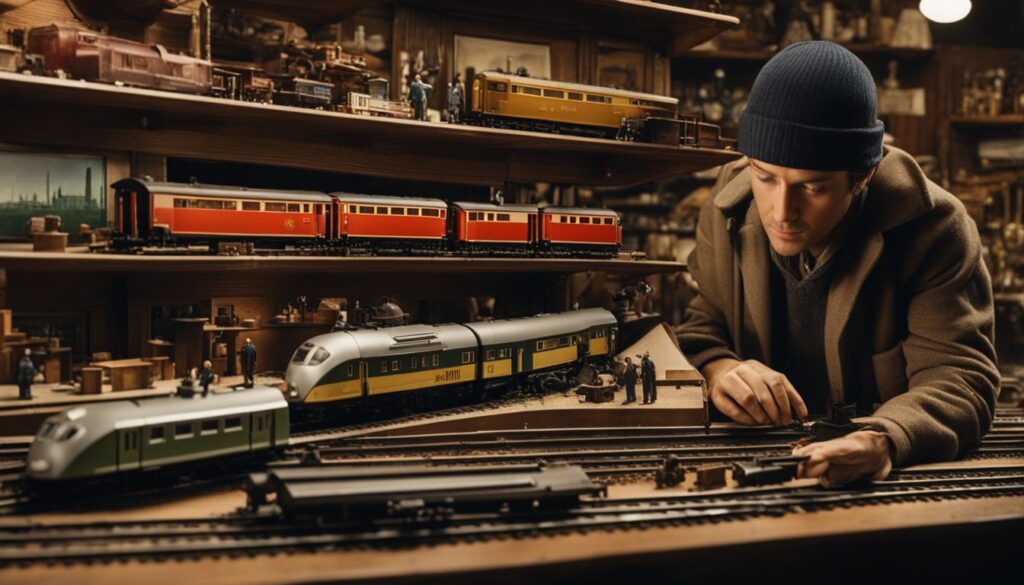

Showcasing Realism in a Small Space
Even though shelf layouts for model trains are small, fans can still make them look very real. Detailing, landscapes, weathering, and scale models can really bring a layout to life and keep people interested. The trick is to make a model railroad that looks great and works like the real thing in a small area.
Paying attention to the details is important for making a shelf plan look more real. The scenery should be based on the chosen theme or prototype, with carefully designed houses, landscapes, and other structures that take people to a certain time or place. Buildings and rolling stock can look more realistic and old by adding weathering. This can make the plan look more real.
Scale models are an important part of making a model train look real. Fans can get a better sense of realism by choosing high-quality models that are true to the time period or concept they are interested in. These scale models bring the plan to life and help make the scene look more real.
“The attention to detail for model railway shelf layouts is what sets it apart and makes it truly remarkable. Every element, from the scenery to the weathering, contributes to the overall realism and creates a captivating experience for viewers.” – Model Railway Enthusiast
Table: Techniques for Enhancing Realism in Shelf Layouts
| Technique | Description |
|---|---|
| Scenic Detailing | Adding realistic scenery elements such as trees, buildings, and roads that reflect the chosen era or location. |
| Weathering | Applying realistic weathering techniques to structures and rolling stock to simulate wear and tear. |
| Scale Models | Using accurate and high-quality scale models that depict the chosen era or prototype. |
| Static Grass Application | Applying static grass to create realistic grassy areas and enhance the overall appearance of the landscape. |
First, modelers can make realistic and beautiful model railway shelf layouts by using these methods. Additionally, by paying attention to the smaller details, they can create layouts that will stick with people for a long time. Furthermore, the goal is to take viewers into a small world that captures the spirit and essence of real railways, even though room is limited.
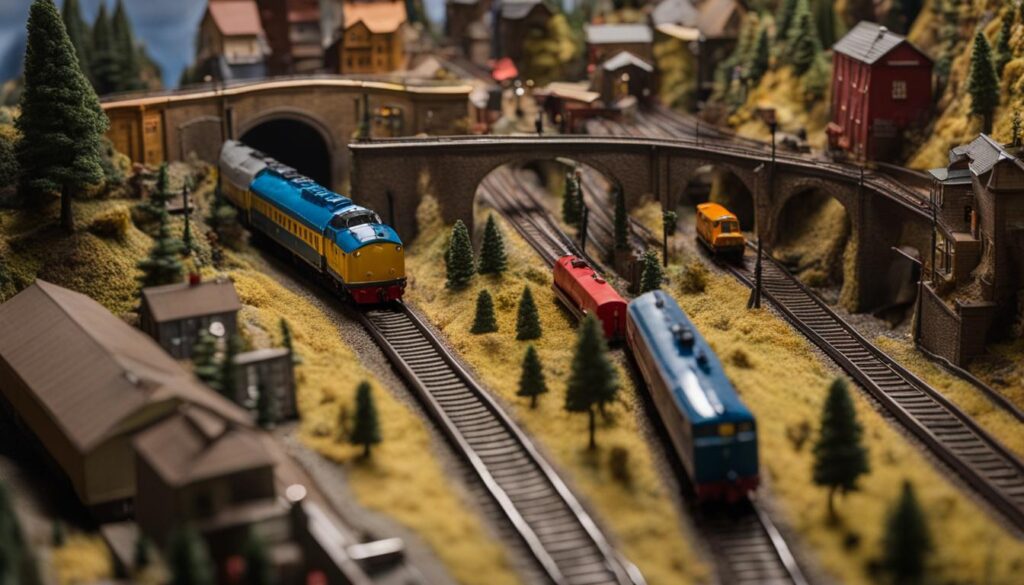

Showcasing Creativity and Theme in Shelf Layouts
Shelf plans for model trains give fans a unique way to express their imagination and make a theme come to life. Modelers can turn their plans into interesting dioramas that tell a story or bring to mind a certain time or place by using prototypes as inspiration or coming up with their own theme. Every part, from the carefully picked out buildings and landscape features to the carefully placed figures, adds to the overall theme and makes the experience visually beautiful and immersive.
Storytelling is very important in the world of model railroading. The trains can be the main characters in each shelf layout, which can be a story ready to happen. Storytelling can be used in a lot of different ways in shelf layouts. It can be used to recreate a historical event, capture the charm of a small town, or mimic the noise and activity of a big city. These plans stand out because of how well they pay attention to detail and how they can take viewers to a different time and place.
One of the best things about shelf layouts is that they let you show off your imagination in a focused and intense way. In bigger layouts, the eye is often drawn to how big the scene is. A shelf layout, on the other hand, needs careful composition and accuracy. Every inch of space can be used to show off unique features and small details that fit with the theme as a whole. The small size forces modelers to be creative with how they use space, which leads to plans that are both nice to look at and make you think.
Examples of Creative Model Railway Shelf Layouts Themes
| Theme | Description | Image |
|---|---|---|
| Wild West Saloon | A slice of the Old West with a bustling saloon, horse-drawn carriages, and a train station. | |
| Fantasy Realm | A mythical land inhabited by magical creatures, towering castles, and a mystical train. |   |
| Industrial Revolution | An industrial cityscape with factories, smokestacks, and a network of steam-powered trains. |
“Every model railway shelf layouts creation is a small world waiting to be explored. By incorporating creativity and theme into these miniature dioramas, modelers can transport viewers to different eras, locations, and imagined realms.” – Model Railway Magazine
Model railroaders can show their love and creativity in a small but visually appealing way by adding creativity and theme to their shelf setups. Whether it’s through careful attention to detail, carefully chosen structures, or a carefully thought-out theme, these tiny worlds make both the people who make them and the people who look at them happy and inspired.
Incorporating Technology in Shelf Layouts
Technology is a big part of making model railway shelf layouts more fun to use generally. Miniature train fans can make their layouts more realistic and fun by adding more complex systems and features. The following are some important tools that can be used in shelf layouts:
Digital Command Control (DCC) Systems
DCC systems make it possible to precisely control and automate trains, giving shelf layouts a level of realism that has never been seen before. With DCC, modelers can handle multiple trains at once, change the speeds of the trains, and program them to do different things. This technology lets the trains move realistically, like speeding up and slowing down and going smoothly, which makes the layout more fun overall.
Sound effects and lights
Adding sound effects and lighting to model train shelf layouts can make the environment more realistic and interesting. With different levels of brightness and color, lighting can be used to make scenes look like they are day or night. Sound effects, like a locomotive chugging or a train whistle, can make the plan seem even more real and bring it to life.
Automation and Control Systems
Automation systems let you run the track without using your hands, which makes it easier to control how the trains move and do other tasks. Modelers can make automated situations with sensors and computer-controlled parts, like trains starting and stopping at stations or events happening when certain conditions are met. This gives the plan a new level of moving and interacting parts.
It is possible for model train fans to make their shelf layouts into more realistic and immersive small worlds by adding these technologies. Technology makes it possible to make a lot of different fun and interesting model railroad experiences. For example, you can use DCC systems to precisely control the trains, lighting and sound effects to create the right mood, or automation and control systems to make the experiences more interactive.
Showcasing Shelf Layouts in Compact Furniture
Shelf plans aren’t just for model trains; they can also be a big part of your home decor. You can make hidden layouts that look great in your living room by putting your model railroad into small pieces of furniture like coffee tables or bookshelves. Imagine having your coffee in the morning while a small railroad runs under the glass tabletop, or putting your favorite books on a desk that can also be used as a track. It’s an original and creative way to show how much you love trains while making the most of the room you have.
To illustrate the concept of furniture integration, here’s an example of a coffee table railroad:
| Design | Description |
|---|---|
  | A custom-built coffee table with a glass top and a hidden compartment for a train layout. The table features a scenic countryside with trees, buildings, and a small train station. The train runs on a circular track, providing endless hours of entertainment and conversation. |
“Having a coffee table railroad in our living room has brought so much joy to our family and guests. It’s a unique piece of furniture that sparks conversations and brings back nostalgic memories. Everyone loves watching the trains go by while enjoying a cup of coffee.”
These hidden layouts are not only useful pieces of furniture, but they also give your home a fun and creative touch. They become a conversation starter and a focus point, showing off your love for model trains in a clever and attractive way.
Showcase of Model Railway Shelf Layouts
Are you ready to get ideas? In this part, you can see examples, photos, and videos of different model train shelf layouts. Look into the different styles, themes, and methods that other fans have used to make their own unique layouts. These displays show the creativity and ingenuity of model railroad fans who have adopted the shelf layout idea. They range from small switching layouts to larger shelf railroads.
Through photos and videos, you can take a virtual tour of some very nice model railroad shelf layouts. These tiny worlds have a lot of realistic details, realistic scenery, and smart use of space that will inspire you. These showcases have a lot of ideas for your own layout, whether you’re a beginner looking for tips or an expert modeler looking for fresh ideas.
Examples of Model Railway Shelf Layouts
Here are a few examples to spark your creativity:
- A small layout with mountainous scenery and tracks that wind around corners
- A layout with an industrial theme that has a busy train yard and companies
- A beautiful layout in the country with rolling hills, farms, and cute towns
- A historical layout that shows a certain time or place with accurate information from that time
Every plan is different and shows off the skills and creativity of the modeler. You can use these examples as a guide and change them to fit your own tastes and needs. There is a model railway shelf layout that will catch your imagination, whether you like steam locomotives, modern freight trains, cities, or the country.
Tips for Building and Maintaining a Shelf Layout
To make sure it works well and lasts a long time, building and keeping a shelf layout requires careful construction methods and regular maintenance. As you build and take care of your model train shelf layouts, here are some tips and suggestions to help you:
1. Construction
When constructing your shelf layout, it’s essential to pay attention to the details to create a sturdy and well-functioning design. Consider these construction tips:
- Ensure a solid foundation: Use sturdy materials to build your shelf or support structure, ensuring it can withstand the weight of your layout.
- Track alignment: Take time to ensure accurate track alignment and smooth transitions between sections. Properly aligning the tracks will prevent derailments and ensure smooth train operations.
- Electrical wiring: Plan your electrical wiring carefully to ensure reliable and efficient power distribution throughout your layout. Use quality wiring and connectors to minimize the risk of electrical issues.
- Scenery construction: Take a creative approach to constructing scenic elements, such as buildings and landscapes, using lightweight materials and techniques that ensure durability and easy maintenance.
2. Maintenance
Ongoing maintenance is crucial to keep your shelf layout in top condition and prevent any issues that may arise. Consider these maintenance tips:
- Regular track cleaning: Dust and debris can accumulate on your tracks, affecting train performance. Regularly clean your tracks using appropriate tools, such as track cleaning cars or cleaning fluids, to ensure smooth operations.
- Troubleshooting common issues: Familiarize yourself with common issues that may arise, such as electrical connectivity problems or track misalignment, and learn how to troubleshoot them effectively. This will help you address any issues promptly and keep your layout running smoothly.
- General upkeep: Regularly inspect your layout for signs of wear and tear, such as loose scenery, damaged tracks, or malfunctioning electrical components. Fix any issues promptly to prevent further damage and ensure the longevity of your layout.
Table: Essential Tools for Building and Maintaining a Shelf Layout
| Tool | Purpose |
|---|---|
| Screwdriver Set | For assembling and disassembling layout components |
| Pliers | For bending and shaping wires, fixing track connectors, and general layout maintenance |
| Track Cleaning Car | For regular cleaning of tracks to ensure smooth train operations |
| Electrical Tester | To check for electrical connectivity and troubleshoot wiring issues |
| Paintbrush Set | For painting scenery and adding detail to structures and landscapes |
By following these tips for construction and maintenance, you can ensure the successful creation and continued enjoyment of your model railway shelf layouts
Conclusion
Finally, model railway shelf plans are a great way for train fans who don’t have a lot of room to display their trains. These small setups not only make model railroading more realistic and fun, but they also show how creative and resourceful modelers can be.
Train fans can make sure their shelf layouts are fun for hours by making the most of operations through switching and different situations. Another way to make something look very real is to pay attention to the scale models, surroundings, weathering, and details.
Adding technology like DCC systems and lighting makes the experience even better and makes the plan feel more real. Also, putting shelf layouts into small pieces of furniture makes hidden layouts that fit in with the decor and make the best use of space.
No matter how skilled or new you are as a modeler, there are a lot of ways to make interesting shelf layouts. Additionally, don’t wait any longer—start making plans for your own model railway shelf layouts right now and start the fun and rewarding process of building a tiny railroad.
FAQ
What are model railway shelf layouts?
Model railway shelf layouts are small and efficient ways to organize model railways so that train fans can make interesting and accurate layouts on shelves or other small surfaces.
What are the benefits of shelf layouts for model railways?
Not only do shelf layouts look more like real trains, they are also small and easy to store, and they save money because they need less track and rolling stock.
What factors should be considered when designing a shelf layout?
When planning a shelf layout, you should think about how to use the room you have, the layout’s size and shape, the arrangement of tracks and train movements, and how to add realistic scenery.
How can operations be maximized on a shelf layout?
You can get the most out of a shelf layout by adding switching operations, creating industries and sidings that need trains to move, and planning different situations and challenges for different train operations.
How can a high level of realism be achieved in a small space?
A shelf layout can look much better if you pay attention to the little things, like using scale models, accurate scenery, and weathering on buildings and rolling stock.
How can creativity and theme be incorporated into shelf layouts?
You can add creativity and a theme to shelf layouts by getting ideas from prototypes, coming up with your own themes, and picking out buildings, landscape features, and figures that tell a story or make you think of a certain time or place.
Can technology be integrated into shelf layouts?
Yes, computers called Digital Command Control (DCC) systems can be used to add technology to shelf layouts. These systems allow precise control and automation of trains, and they can also be used to add lighting and sound effects for atmosphere and interaction.
Can shelf layouts be integrated into furniture?
Yes, shelf layouts can be built into small pieces of furniture like coffee tables or bookshelves. This lets you make hidden layouts that go with your overall style and make the best use of the room you have.
Where can I find examples, photos, and videos of model railway shelf layouts?
In our showcase area, you can find photos, videos, and examples of model railway shelf layouts that can help you come up with ideas for your own.
What tips are there for building and maintaining a shelf layout?
Some tips for building and keeping a shelf layout are to lay the tracks, wire the power, build the scenery, do general maintenance, and learn how to fix common problems and avoid them in the first place.


